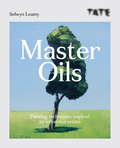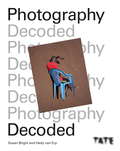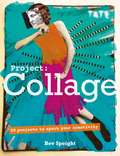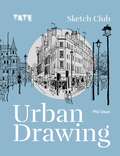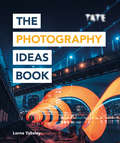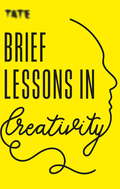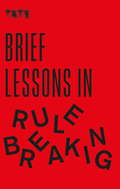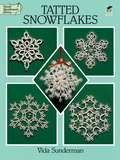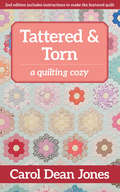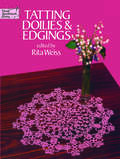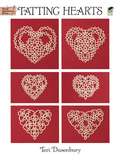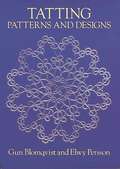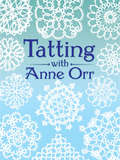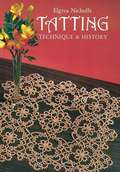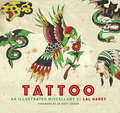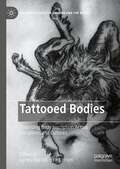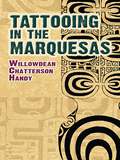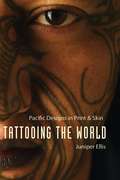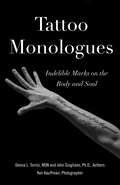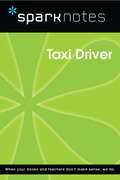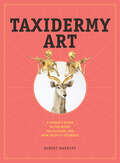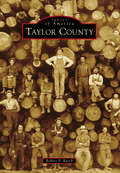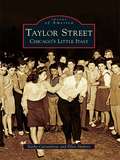- Table View
- List View
Tate: Painting techniques inspired by influential artists (Tate #2)
by Selwyn LeamyLearn how to paint in the fantastic medium of oil. Taking inspiration from iconic paintings in the Tate Collection, discover the techniques of the masters and improve your own painting skills with 30 guided projects. Master brushwork and form with Cézanne; thin and blend with Turner and Whistler; and play with texture with Richter and Riley.
Tate: Photography Decoded (Tate #9)
by Susan Bright Hedy Van ErpIs it real?What do I remember?How can you tell a story?Can lying be OK?What goes where?Why is it famous?What makes it problematic?Who do you think you are?Stealing or borrowing?Public or private?These ten questions launch a thought-provoking investigation into what is really going on when you look at a photograph. Peeling back the layers of everything from the earliest daguerreotypes to your latest selfie, you will discover where to find meaning in an image, and the ways in which the photographer, our current culture, and you yourself all collaborate in the creation of that meaning.
Tate: Project Collage (Tate Ser.)
by Bev SpeightCut it, stick it, twist it! Collage is the art of reinvention, a magical and tactile process that invites you to collect, experiment, combine and transform. Requiring no specialist equipment - only everyday materials - it is an art form for everyone and every budget. From striking architectural builds to mixed-media menageries, this book offers fresh ideas and guidance to help you cut and paste your way to your own unique artworks.
Tate: Sketch Club Urban Drawing
by Phil DeanUrban sketching has become one of the biggest art trends of the last decade, with artists preferring to capture a scene on location rather than relying on a photograph. Featuring 20 step-by-step exercises, Sketch Club: Urban Drawing is your essential guide to putting your drawing skills into practice on location. You'll learn how to start, when to stop and how to fix common mistakes. Packed with all the energy and inspiration of a drawing group, this is the ideal book for anyone looking to take their urban drawing further. Perfect your urban drawing skills and develop your own unique style with professional urban sketcher, Phil Dean. Chapters include:- Loosening Up- Building a Scene- Adding Contrast- Taking it Further- Finishing Touches
Tate: Sketch Club Urban Drawing (Sketch Club Ser.)
by Phil DeanUrban sketching has become one of the biggest art trends of the last decade, with artists preferring to capture a scene on location rather than relying on a photograph. Featuring 20 step-by-step exercises, Sketch Club: Urban Drawing is your essential guide to putting your drawing skills into practice on location. You'll learn how to start, when to stop and how to fix common mistakes. Packed with all the energy and inspiration of a drawing group, this is the ideal book for anyone looking to take their urban drawing further. Perfect your urban drawing skills and develop your own unique style with professional urban sketcher, Phil Dean. Chapters include:- Loosening Up- Building a Scene- Adding Contrast- Taking it Further- Finishing Touches
Tate: The Photography Ideas Book
by Lorna YabsleyIt's time to refresh your creativity with this lively exploration of photography at the cutting edge. There's always a new angle with which to shoot your subject, a different shade of light to capture or a completely new genre to try out, so there's never an excuse for your camera to gather dust. This little book is full of big ideas that will inspire you to think differently. With a new concept on every page, you will discover fresh ways of tackling your subjects to create work that is original and exciting.
Tate: the perfect SECRET SANTA present
by Frances Ambler'Creative people are curious, flexible, persistent and independent with a tremendous spirit of adventure and a love of play.' - MatisseUse this essential guide to crack artistic algorithms and improve, sustain and nurture your creativity. Brief Lessons in Creativity presents a rich variety of artistic methods and solutions for you to try, and is packed with inspiration and practical takeaways. Stay curious like Rauschenberg by immersing yourself in the world through seeing, reading and researching. Repeat and revisit with Cézanne to try things differently, and collect and remix with Matisse and Bacon. Appreciate the importance of solitude and space with Bourgeois, and improvise freely with Van Gogh. With every chapter, learn how to create your best work and embrace a new sense of playfulness.
Tate: the perfect SECRET SANTA present
by Frances Ambler'Learn the rules like a pro so you can break them like an artist'- PicassoWhether it's through disrupting a routine, turning an idea on its head or challenging the norm, Brief Lessons in Rule Breaking will give you the confidence to take creative risks and experiment, free from self-doubt. Be inspired by the artistic avant garde with wise words from Abramovic, Duchamp and more.
Tatted Snowflakes
by Vida SundermanHang them on Christmas tree branches or evergreen boughs during the holiday season. Use them to dress up holiday packages or a holiday table centerpiece. Or frame these exquisite works of art and give them to friends and family as gifts at any season of the year. This excellent guide shows you how to tat 40 distinctive snowflake designs in many different sizes -- each a model of elegant craftsmanship.Needlecraft designer Vida Sunderman has provided easy-to-follow instructions to help needleworkers bring each of these beautiful designs to a happy conclusion. Forty close-up photos show the completed designs, including two three-dimensional snowflakes and some enhanced with ribbons, beads, jewels, or glitter. Some of the designs are suitable for beginning tatters, while others require intermediate and advanced skill levels. Every one of them, when completed, will add a personal touch of elegance to the holiday season.
Tattered & Torn: A Quilting Cozy
by Carol Dean JonesAn antique quilt entangles a senior sleuth in foul play in this mystery from the author of Missing Memories. Bonus quilt pattern included! When sixty-eight-year-old Sarah Miller moves into the Cunningham Village retirement community, she is mourning the loss of her husband, her young grandson, and the place that has been home for forty-two years. But Sarah is a survivor. As she reaches out into the retirement community that is to become home, she finds friends, activities, new hobbies, and a possible love interest. The ninth installment of this fun, friendly series of cozy mysteries draws together a tattered quilt, an exhaustive search through the past, a murder suspect, and a grand jury hearing into a compelling mystery.
Tatting Doilies and Edgings
by Rita WeissWhether you are an experienced tatter or a beginner, this rare collection of patterns gives needleworkers instructions for making over thirty tatted doilies and almost fifty edgings for fine linens, towels, handkerchiefs, collars, placemats, and other items. Included are such lovely items as tatted edgings, a bread tray doily, handkerchief edgings, edgings for fine linens, luncheon sets, chair sets, a lace elegance doily, and an anemone doily. For those completely new to tatting there are step-by-step tatting instructions including how to wind and work with the shuttle and make all of the stitches necessary to complete the projects. Unlike other historic collections, all of these patterns will be recognized as immediately usable for today's home and fashions.
Tatting Hearts
by Teri DusenburyTatting as we know it evolved from knotting techniques dating back thousands of years. The Pilgrims brought the craft to America and today this beautiful and delicate form of lacework is more popular than ever. This guide to tatting by a veteran needlecrafter provides explicit, clearly written instructions and over 100 illustrations for making 12 different tatted hearts. To create these lovely patterns, the author has developed two new techniques -- "directional tatting," a short-cut tactic involving reverse stitches, and "stacking," a method that gives tatting a three-dimensional look. Also incorporated in the patterns is a variation on the split ring technique perfected in the 1920s by the noted designer Anne Orr. Many of the designs are simple enough for a beginner, while others will catch the interest of even the most experienced of tatters. Perfect as tabletop accents or as framed works of art, each of these completed, lovely heart-shaped designs is shown in a separate photograph. And as an extra bonus, there's a photo of a mobile utilizing all the patterns.
Tatting Patterns and Designs
by Elwy Persson Gun BlomqvistHere is a distinctive gallery of over 85 beautiful and useful tatted items -- mats, bookmarks, edgings, collars, crowns, medallions, and more -- all ideal for resting and developing the skills of both intermediate and advanced tatters.Created and compiled by two well-known crafts and needlework experts, teachers, and editors, these delicate designs include the dainty Annette and charming Margareta -- lovely edgings that will add a touch of elegance to fine linens, handkerchiefs, and personal apparel -- and exquisite doilies such as Mignonette and Peony, perfect for use as centerpieces, vanity sets, and table settings.Each project is clearly photographed and detailed instructions specify what thread to use, the size of the design and number of shuttles needed, tatting stitches involved, and proper sequence for each. Also included are a brief history of this great traditional craft and instructions on its principal techniques.
Tatting with Anne Orr
by Anne OrrRare patterns created during the 1920s, 30s, and 40s by a legendary needlework designer offer a treasury of more than 100 delicate designs: 50 edgings, 40 medallions, 3 collars and yokes, 7 doilies, 3 luncheon sets, and 4 baby items. Step-by-step directions and sharply detailed photos allow even beginners to create keepsake treasures.
Tatting: Technique and History
by Elgiva NichollsTatting is the age-old art of making delicate handmade lace by looping and knotting a single cotton thread held on a small shuttle. Sometimes called "the poor man's lace," it requires very little outlay for materials or tools, yet produces beautiful and decorative effects. Anyone with patience and a little dexterity, can make elegant edgings and insertions for lingerie; collars or edgings for collars; yokes for blouses and nightdresses; short-sleeved cardigans; trimmings for bedclothes, handkerchiefs, and fine linens; and many other attractive items.In this comprehensive and informative guide, a noted tatting expert defines and explains the craft (including a helpful glossary of tatting terms), explains its history and development, and provides clear, profusely illustrated instructions in the art of tatting.To meet the needs of both beginning and experienced tatters, the author has divided the book into two parts. Part One, for the novice, offers excellent coverage of materials and tools, making the stitch, the continuous thread, patterns, special arrangements of stitches, working with multiple threads, and finishing the work.Throughout, you'll find clear step-by-step instructions supplemented by nearly 60 drawings and photographs. In addition, patterns are progressive in difficulty; mastery of the simple versions will enable you to undertake more elaborate projects. Whatever project you select, this superb handbook offers the knowledge, guidance, and inspiration you need to discover the creative satisfaction and lasting rewards of tatting.
Tattoo: An Illustrated Miscellany
by Lal Hardy'Beautiful, inspiring and informative' - BidishaLondon tattoo legend Lal Hardy reveals the fascinating hidden world of tattoo, past and present.With a wealth of previously unpublished photographs, details and anecdotes, Tattoo preserves many unique and valuable items of tattoo culture, including:· Historical stencils and flash· Customised machines, traditional hand-tools and animal-marking equipment· Collector's cards, bubblegum cards and transfers· Memorabilia and tributes relating to tattoo legends such as George Burchett and The Great Omi· Postcards, toys, ornaments, T-shirts and other merchandise· Supply catalogues, magazines, books and art· Rare ephemera - awards, badges, business cards, convention passes, postage stamps and hand-drawn signsLAL HARDY was born in London in 1958. He opened New Wave Tattoo in north London's Muswell Hill when he was just twenty-one years old. Lal is part of an international community of highly respected tattoo artists. This is his sixth book.MATT LODDER is an expert on body art and body modification. He is the author of Tattoo: An Art History and is Director of American Studies at the University of Essex.
Tattooed Bodies: Theorizing Body Inscription Across Disciplines and Cultures (Palgrave Studies in Fashion and the Body)
by James Martell Erik LarsenThe essays collected in Tattooed Bodies draw on a range of theoretical paradigms and empirical knowledge to investigate tattoos, tattooing, and our complex relations with marks on skin. Engaging with diverse disciplinary perspectives in art history, continental philosophy, media studies, psychoanalysis, critical theory, literary studies, biopolitics, and cultural anthropology, the volume reflects the sheer diversity of meanings attributed to tattoos throughout history and across cultures. Essays explore conceptualizations of tattoos and tattooing in Derrida, Deleuze and Guattari, Lacan, Agamben, and Jean-Luc Nancy, while utilizing theoretical perspectives to interpret tattoos in literary works by Melville, Beckett, Kafka, Genet, and Jeff VanderMeer, among others. Tattooed Bodies prompts readers to explore a few significant questions: Are tattoos unique phenomena or an art medium in need of special theoretical exploration? If so, what conceptual paradigms and theories might best shape our understanding of tattoos and their complex ubiquity in world cultures and histories?
Tattooing in the Marquesas
by Willowdean Chatterson HandyThis definitive source on the intricate tattoos of Polynesia's Marquesas Islands offers a rare glimpse of a dying art. Because of the colonial authorities' 1884 ban on tattooing, there remained only a single surviving tattoo artist at the time of this 1921 survey—and a dwindling number of living examples. These 38 plates of black-and-white drawings and photographs provide an unusually complete and intimate record of a sophisticated art form.The Marquesas consist of a dozen rugged volcanic islands that lie 1,000 miles northeast of Tahiti. Rich in oral traditions, folklore, and decorative arts, their complex culture was devastated by the intrusions of outsiders during the nineteenth century. In the early 1920s, Hawaii's Bishop Museum sponsored an expedition to preserve what was left of the islanders' vanishing world. Willowdean Chatterson Handy, an expedition associate, created this priceless record of the ancient body art rituals. In addition to detailed information about tattoo methods and customs, Handy's account features fascinating insights into the designs' symbolic significance and their representation of social status. Her painstaking drawings of tattoo patterns are accompanied by captions that explain the traditional motifs.
Tattooing the World: Pacific Designs in Print and Skin
by Juniper EllisIn the 1830s an Irishman named James F. O'Connell acquired a full-body tattoo while living as a castaway in the Pacific. The tattoo featured traditional patterns that, to native Pohnpeians, defined O'Connell's life; they made him wholly human. Yet upon traveling to New York, these markings singled him out as a freak. His tattoos frightened women and children, and ministers warned their congregations that viewing O'Connell's markings would cause the ink to transfer to the skin of their unborn children. In many ways, O'Connell's story exemplifies the unique history of the modern tattoo, which began in the Pacific and then spread throughout the world. No matter what form it has taken, the tattoo has always embodied social standing, aesthetics, ethics, culture, gender, and sexuality. Tattoos are personal and corporate, private and public. They mark the profane and the sacred, the extravagant and the essential, the playful and the political. From the Pacific islands to the world at large, tattoos are a symbolic and often provocative form of expression and communication.Tattooing the World is the first book on tattoo literature and culture. Juniper Ellis traces the origins and significance of modern tattoo in the works of nineteenth- and twentieth-century artists, travelers, missionaries, scientists, and such writers as Herman Melville, Margaret Mead, Albert Wendt, and Sia Figiel. Traditional Pacific tattoo patterns are formed using an array of well-defined motifs. They place the individual in a particular community and often convey genealogy and ideas of the sacred. However, outside of the Pacific, those who wear and view tattoos determine their meaning and interpret their design differently. Reading indigenous historiography alongside Western travelogue and other writings, Ellis paints a surprising portrait of how culture has been etched both on the human form and on a body of literature.
Tattoo Monologues: Indelible Marks on the Body and Soul
by Donna L. Torrisi John GiuglianoBody art can tell personal stories. When linked to a difficult or traumatic life, it can even restore one&’s sense of well-being. As director of a community health center for twenty-seven years and as a nurse practitioner for over forty years, Donna Torrisi became fascinated with the stories behind her patients&’ tattoos. When she began to ask her female patients about their markings, themes of trauma, pain, and loss emerged, and it became clear that the art indelibly marked on their bodies had played a part in their healing and redemption.The women featured in Tattoo Monologues demonstrate vulnerability and courage as they share both their personal tattoo narratives and photos of the images on their bodies. These women represent diverse cultures, ethnicities, and professional contexts, but they are united by their use of tattoos as a tool for processing traumatic life experiences. The images, stories, emotions, and journeys in this book collectively tell a compelling story. A story of skin and ink. A story of trauma and adversity. A story of courage and resilience.
Taxi Driver (SparkNotes Film Guide)
by SparkNotesTaxi Driver (SparkNotes Film Guide) Making the reading experience fun! SparkNotes Film Guides are one-stop guides to great works of film–masterpieces that are the foundations of filmmaking and film studies. Inside each guide you&’ll find thorough, insightful overviews of films from a variety of genres, styles, and time periods. Each film guide contains:Information about the director and the context in which the film was made Thoughtful analysis of major characters Details about themes, motifs, and symbols Explanations of the most important lines of dialogue In-depth discussions about what makes a film so remarkable SparkNotes Film Guides are an invaluable resource for students or anyone who wants to gain a deeper understanding of the great films they know and love.
Taxidermy Art: A Rogue's Guide to the Work, the Culture, and How to Do It Yourself
by Robert MarburyIn this collection of taxidermy art, you’ll find a winged monkey with a fez and a martini glass, a jewel-encrusted piglet, a bionic fawn, and a polar bear balancing on a floating refrigerator. Author Robert Marbury makes for a friendly (and often funny) guide, addressing the three big questions people have about taxidermy art: What is it all about? Can I see some examples? and How can I make my own? He takes readers through a brief history of taxidermy (and what sets artistic taxidermy apart) and presents stunning pieces from the most influential artists in the field. Rounding out the book are illustrated how-to lessons to get readers started on their own work, with sources for taxidermy materials and resources for the budding taxidermist.
Taxidermy Goes Wild!: The funkiest, freakiest (and outright creepiest) beastly scenes
by Rob ColsonStuffed with a wonderfully weird collection of taxidermy from across the globe, Taxidermy Goes Wild will leave you both amused and confused. Revel in scenes of musical mice, basket-balling bengals, gun-toting rodents and lawn-mowing moles.Bringing together all the scenes nature never intended, this full-colour volume really does showcase the bizarre taxidermy on sale and on display. From a swearing squirrel in a London antiques shop, to a murderous mouse serving arsenic in a New York store, nothing is off-limits. Taxidermy Goes Wild is the very best - and the very worst - of anthropomorphic wildlife.
Taylor County
by Robert P. RuschWhen Wisconsin became a state in 1848, its densely forested north awaited railroad construction before settlement. Taylor County, the "Garden Spot of Northern Wisconsin," was founded on March 4, 1875. Named for then-governor William R. Taylor, the area was primarily forested with eastern hemlock. The county's portion of the Wisconsin Central Railroad was built in 1873, and station sites were named for suburbs of Boston, including Medford, Charlestown, Chelsea, and Westboro. The county's early years were dominated by lumbering and leather tanning, the latter made possible by tannic acid leached from hemlock bark. By 1900, dairy farms dotted its glacial hills. Today, Taylor County's municipalities are home to diverse industries, ranging from snowshoe manufacturing to America's largest pizza plant.
Taylor Street: Chicago's Little Italy (Images of America)
by Ellen Shubart Kathy CatramboneChicago's Near West Side was and is the city's most famous Italian enclave, earning it the title of "Little Italy." Italian immigrants came to Chicago as early as the 1850s, before the massive waves of immigration from 1874 to 1920. They settled in small pockets throughout the city, but ultimately the heaviest concentration was on or near Taylor Street, the main street of Chicago's Little Italy. At one point a third of all Chicago's Italian immigrants lived in the neighborhood. Some of their descendents remain, and although many have moved to the suburbs, their familial and emotional ties to the neighborhood cannot be broken. Taylor Street: Chicago's Little Italy is a pictorial history from the late 19th century and early 20th century, from when Jane Addams and Mother Cabrini guided the Italians on the road to Americanization, through the area's vibrant decades, and to its sad story of urban renewal in the 1960s and its rebirth 25 years later.
